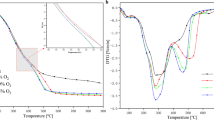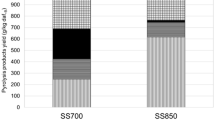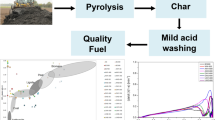Abstract
A study on pyrolysis, steam gasification, and carbonization-activation was conducted to produce energy and resource from waste sewage sludge. Carbonization-activation is a sequential process of pyrolysis and steam gasification. The experiment was conducted with a batch-type fixed bed reactor. A comparative analysis on the formation characteristics of products, such as gas, tar, and char, was conducted to evaluate the three cases. For sludge char, carbonization-activation showed the largest amount of porosity in the char, and its specific surface area was 80.28 m2/g with an average pore diameter of 6.229 nm. The best adsorption ability of benzene, a light tar, was 175 mg/g. For the producer gas, steam gasification obtained the largest amount of 20.1 L. Similarly, carbonization-activation showed a large value of 16.6 L. Hydrogen and carbon monoxide concentrations were higher in the producer gas due to steam reforming compared with carbonization-activation. Energy yields were 209 kJ and 226 kJ for steam gasification and carbonization-activation, respectively.
The amount of tar formation did not show a significant difference, but the largest one was found in steam gasification. The gravimetric tar amount for steam gasification was 23.5 g/Nm3. However, the selected light tar displayed the lowest concentration for the carbonization-activation. Such concentrations were 2.79 g/Nm3, 0.75 g/Nm3, 0.14 g/Nm3, and 0.14 g/Nm3 for benzene, naphthalene, anthracene, and pyrene, respectively. Therefore, carbonization-activation was found to be the most effective process for producing high quality sludge char and producer gas for utilizing waste sludge into renewable energy and resources.
Similar content being viewed by others
References
J. ábrego, J. Arauzo, J. L. Sánchez, A. Gonzalo, T. Cordero and J. Rodríguez-Mirasol, Structural changes of sewage sludge char during fixed-bed pyrolysis, Industrial & Engineering Chemistry Research, 15 (2009) 3211–3221.
T. Karayildirim, J. Yanik, M. Yuksel and H. Bockhorn, Characterisation of products from pyrolysis of waste sludges, Fuel, 85 (2006) 1498–1508.
N. Nipattummakul, I. I. Ahmed, S. Kerdsuwan and A. K. Gupta, Hydrogen and syngas production from sewage sludge via steam gasification, International Journal of Hydrogen Energy, 35 (2010) 11738–11745.
H. J. Park, H. S. Heo, Y. K. Park, J. H. Yim, J. K. Jeon, J. H. Park, C. K. Ryu and S. S. Kim, Clean bio-oil production from fast pyrolysis of sewage sludge: Effects of reaction conditions and metal oxide catalysts, Bioresource technology, 101 (2010) S83–S85.
T. J. Bandosz and K. Block, Effect of pyrolysis temperature and time on catalytic performance of sewage sludge/industrial sludge-based composite adsorbents, Applied Catalysis B, 67 (2006) 77–85.
D. T. Furness, L. A. Hoggett and S. J. Judd, Thermochemical treatment of sewage sludge, Water and Environment Journal, 14 (2000) 57–65.
I. Fonts, E. Kuoppala and A. Oasmaa, Physicochemical properties of product liquid from pyrolysis of sewage sludge, Energy Fuels., 23 (2009) 4121–4128.
A. Fullana, J. A. Conesa, R. Font and I. Martin-Gullón, Pyrolysis of sewage sludge: nitrogenated compounds and pretreatment effects, Journal of Analytical and Applied Pyrolysis, 68–69 (2003) 561–575.
T. Phuphuakrat, T. Namioka and K. Yoshikawa, Tar removal from biomass pyrolysis gas in two-step function of decomposition and adsorption, Appled Energy, 87 (2010) 2203–2211.
J. Good, L. Verenum, H. Knoef, U. Zielke, P. L. Hansen, W. van de Kamp, P. de Wild, B. Coda, S. van Paasen, J. Kiel, K. Sjöström, T. Liliedahl, C. H. Unger, J. Neeft, M. Suomalainen and P. Simell, Sampling and analysis of tar and particles in biomass producer gases. Technical Report, BTG biomass technology group CEN BT/TF 143 (2005).
T. Yamazaki, H. Kozu, S. Yamagata, N. Murao, S. Ohta, S. Shiya and T. Ohba, Effect of superficial velocity on tar from downdraft gasification of biomass, Energy Fuels, 19 (2005) 1186–1191.
Y. N. Chun, S. C. Kim and K. Yoshikawa, System development and analysis for producing high quality gas and activated sludge char, Journal of Mechanical Science and Technology, 26 (2012) 241–250.
Y. I. Son, M. Sato, T. Namioka and K. Yosikawa, A study on measurement of light tar content in the fuel gas produced in small-scale gasification and power generation systems for solid wastes, Journal of Environmental Engineering, 4 (2009) 12–23.
T. Hosoya, H. Kawamoto and S. Saka, Pyrolysis gasification reactivities of primary tar and char fractions from cellulose and lignin as studied with a closed ampoule reactor, Journal of Analytical and Applied Pyrolysis, 83 (2008) 71–77.
K. Umeki, Modelling and simulation of biomass gasification with high temperature steam in an updraft fixed-bed gasifier. Doctoral thesis, Tokyo Institute of Technology (2009).
O. Mašek, M. Konno, S. Hosokai, N. Sonoyama, K. Norinaga and J. I. Hayashi, A study on pyrolytic gasification of coffee grounds and implication to allothermal gasification, Biomass Bioenergy, 32 (2008) 78–89.
B. Zhang, S. Xiong, B. Xiao, Yu. Dongke and X. Jia, Mechanism of wet sewage sludge pyrolysis in a tubular furnace, International Journal of Hydrogen Energy, 36 (2010) 1–9.
E. Pütün, F. Ates and A. E. Pütün, Catalytic pyrolysis of biomass in inert and steam atmospheres, Fuel 87 (2008) 815–824.
T. A. Milne, N. Abatzoglou and R. J. Evans, Biomass gasifier “tars”: Their nature, formation, and conversion. National Renewable Energy Laboratory, NREL/TP-570-25357 (1998).
H. Chent, T. Namiokal and K. Yoshikawa, Comparison of tar behavior and characteristics during pyrolysis and reforming of sewage sludge and wood chips. 8th International SymposiullI on HiTACG, Poznan, Poland, July (2010).
IUPAC, Manual of symbols and terminology of colloid surface. London: Butterworths (1982).
G. Q. Lu, Effect of pre-drying on the pore structure development of sewage sludge during pyrolysis, Environmental Technology, 16 (1995) 495–499.
A. Bagreev, T. J. Bandosz and D. C. Locke, Pore structure and surface chemistry of adsorbents obtained by pyrolysis of sewage sludge-derived fertilizer, Carbon, 39 (2001) 1971–1979.
M. Inguanzo, J. A. Mendez, E. Fuente and J. J. Pis, Reactivity of pyrolyzed sewage sludge in air and CO2, Journal of Analytical and Applied Pyrolysis, 58–59 (2001) 943–54.
Author information
Authors and Affiliations
Corresponding author
Additional information
Recommended by Associate Editor Oh Chae Kwon
Young Nam Chun is Professor of Environmental Engineering at Chosun University. His research interests lie in air pollution control of combustion/ incineration systems, with current emphasis on numerical simulation and experimental interrogation, plasma technology for exhaust gas treatment or hydrogen production, and waste-to-energy conversion technology.
Rights and permissions
About this article
Cite this article
Chun, Y.N., Ji, D.W. & Yoshikawa, K. Pyrolysis and gasification characterization of sewage sludge for high quality gas and char production. J Mech Sci Technol 27, 263–272 (2013). https://doi.org/10.1007/s12206-012-1202-0
Received:
Revised:
Accepted:
Published:
Issue Date:
DOI: https://doi.org/10.1007/s12206-012-1202-0




